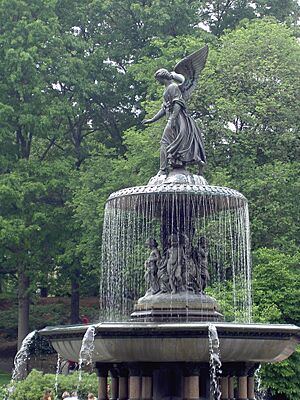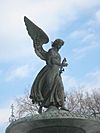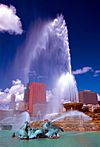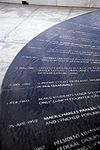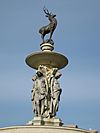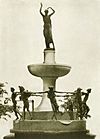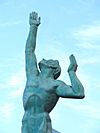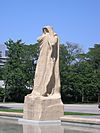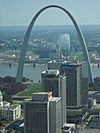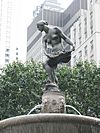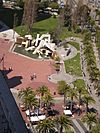History of fountains in the United States facts for kids
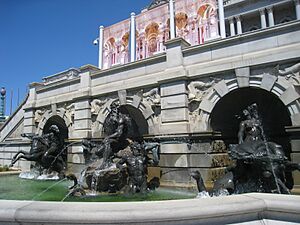
Fountains are special structures that make water flow or shoot into the air. The first decorative fountain in the United States was opened in Philadelphia in 1809. Back then, early American fountains were mainly used to give people clean drinking water. They didn't have much decoration and often looked like European fountains.
Later, in the 1900s, many American fountains stopped being used for drinking water. They became more about beauty and art. These new fountains were built to honor important events or people. Some were like big sculptures in cities, while others tried to look like natural waterfalls. By the late 1900s, a new type of fountain became popular: the musical fountain. These fountains use computers to make water "dance" with lights and music. You can see famous musical fountains in places like Las Vegas, where they are a fun show for everyone.
Early American Fountains (1800-1900)

Philadelphia was the first city in the U.S. to build a city-wide water system. It started working in January 1801. Water from the Schuylkill River traveled through underground pipes. Steam pumps then pushed this water into a tall water tower in Centre Square, which is now where Philadelphia City Hall stands.
An architect named Benjamin Henry Latrobe designed this water system. Centre Square, once a simple field, was turned into a public park. A beautiful fountain was added there between 1808 and 1809. A sculptor named William Rush carved a wooden statue called Allegory of the Schuylkill River for this fountain. It's also known as Water Nymph with Bittern.
New York City also built large fountains to mark the end points of its new water pipes. A serious sickness called cholera in 1832 and a huge fire in 1835 made the city realize it needed more fresh water. So, they built the Croton Aqueduct, which brought water 40 miles from the Croton River to New York City.
When the aqueduct was finished in 1841, a special fountain called the Croton Fountain was turned on in City Hall Park on October 14, 1842. It shot water 50 feet high! Another fountain in Union Square was also connected to this new water system. These first fountains were very simple, just spouting water. They didn't have sculptures and don't exist anymore, but parts of the old water system are still around.
In 1848, Boston also completed its own water system. It brought water from Lake Cochituate, about 20 miles away, to the Boston Common. A big parade and festival celebrated the opening of the first fountain there on October 25, 1848. Schoolchildren even sang a special song written by the poet James Russell Lowell for the event.
While early American fountains were simple and useful, by the 1850s, cities wanted more decorative ones. They were inspired by European designs and aimed to make American cities more beautiful with parks, squares, and fountains.
A great example is the Bethesda Fountain in New York City's new Central Park. This huge park project began in 1858, designed by Frederick Law Olmsted and Calvert Vaux. In the middle of the park, they planned a formal area with elm trees and a terrace overlooking a lake. In 1863, the park leaders decided to build a large fountain for the central part of this area.
The sculptor chosen was Emma Stebbins, an American artist. Her fountain was inspired by a Bible story from the Gospel of John. In the story, an angel touched the waters of the Pool of Bethesda in Jerusalem, giving them healing powers. Stebbins wrote that pure, clean water brings "healing, comfort and purification" to the city's homes, like an "angel visitant." When it opened in 1873, some people didn't like it at first. The New York Times called it "a feebly-pretty idealess thing." But over time, the fountain became very popular and has appeared in many movies and plays.
Modern Fountains (1900-2000)
Between 1900 and 1950, many fountains in the United States still looked like older European or classical styles. For example:
- The beautiful Samuel Francis Dupont Memorial Fountain (also known as Dupont Circle Fountain) in Washington, D.C., was designed in 1921. Its creators, Henry Bacon and Daniel Chester French, also worked on the Lincoln Memorial. It has a pure neoclassical style.
- The Buckingham Fountain in Chicago's Grant Park was one of the first American fountains to use strong modern pumps. These pumps could shoot water as high as 150 feet (46 meters) into the air!
- The Fountain of Prometheus at Rockefeller Center in New York City, built in 1933, was the first American fountain in the Art Deco style. It features a sculpture by Paul Manship.
After World War II, fountains in the U.S. started to look very different. Some, like the Vaillancourt Fountain in San Francisco (1971), were like giant sculptures. The artist, Armand Vaillancourt, built this large fountain in a cubist style. He also wanted it to share a political message, even painting slogans on it when it opened.
Other fountains were designed to be part of a landscape and tell a story. An example is the Franklin Roosevelt Memorial Waterfall (1997), designed by architect Lawrence Halprin. This fountain is part of the Franklin Delano Roosevelt Memorial in Washington, D.C.. The memorial has four outdoor "rooms" that show different parts of President Roosevelt's time in office. Each room has a waterfall or cascade. The one in the third room shows the difficult times of World War II. Halprin wanted the whole memorial to feel like a sculpture that you could "touch, feel, hear and contact - with all the senses."
One of the most unique modern American fountains is the Civil Rights Memorial (1989). It's located at the Southern Poverty Law Center in Montgomery, Alabama. It was designed by Maya Lin, who also designed the Vietnam Veterans Memorial. The Civil Rights Memorial fountain has a low, round table made of black granite. A thin layer of water flows over its surface, where the names of civil rights leaders who lost their lives are carved. This design is inspired by a quote from Martin Luther King Jr.: "...Until justice rolls down like waters and righteousness like a mighty stream." Visitors can touch the names through the water. Lin explained that the water is very still until you touch it, and your hand creates ripples, changing the artwork.
Significant Fountains in the United States
| Name | Image | Location | Architect(s) | Sculptor(s) | Year completed | Notes |
|---|---|---|---|---|---|---|
| Bartholdi Fountain Fountain of Light and Water |
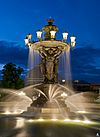 |
United States Botanical Gardens, Washington, D.C. |
Frédéric Auguste Bartholdi | Philadelphia, 1876 Washington, D.C., 1878 |
Shown at the 1876 Centennial Exposition. First U.S. fountain lit by gaslight. |
|
| Bethesda Fountain |  |
Central Park, Manhattan, New York City |
Calvert Vaux | Emma Stebbins | 1873 | "Angel of the Waters" |
| Buckingham Fountain |  |
Chicago, Illinois | Edward H. Bennett | Marcel F. Loyau | 1927 | The central jet shoots up 150 feet (46 m). |
| Centennial Fountain Nicholas J. Melas Centennial Fountain |
 |
Chicago, Illinois | Lohan Associates | 1989 | The jet shoots across the Chicago River. | |
| Civil Rights Memorial |  |
Montgomery, Alabama | Maya Lin | 1989 | Water flows over a table with civil rights events. | |
| Coleman Memorial Fountain | 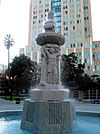 |
Sacramento, California | Ralph Stackpole | 1927 | ||
| Columbus Fountain Christopher Columbus Memorial Fountain |
 |
Union Station, Washington, D.C. |
Daniel Burnham | Lorado Taft | 1912 | "The Spirit of Discovery" looks like a ship's figurehead. |
| Corning Fountain | 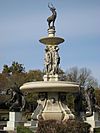 |
Bushnell Park, Hartford, Connecticut |
J. Massey Rhind | 1899 | The hart (deer) represents the City of Hartford. | |
| Court of Neptune Fountain |  |
Thomas Jefferson Building, Library of Congress, Washington, D.C. |
John L. Smithmeyer Paul J. Pelz Edward Pearce Casey |
Roland Hinton Perry Albert Weinert (relief sculpture) |
1895 | Thomas Jefferson Building |
| Depew Memorial Fountain | 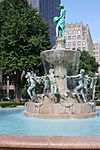 |
Indianapolis, Indiana | Henry Bacon | Karl Bitter Alexander Stirling Calder |
1919 |
Bitter's small model for the fountain. Calder finished the sculpture after Bitter died in 1915. |
| Donahue Memorial Fountain The Mechanics Monument |
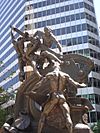 |
San Francisco, California | Willis Polk | Douglas Tilden | 1901 | The fountain survived the 1906 San Francisco earthquake. |
| Dupont Circle Fountain Rear Admiral Samuel Francis Dupont Memorial Fountain |
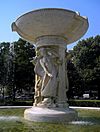 |
Dupont Circle, Washington, D.C. |
Henry Bacon | Daniel Chester French | 1921 | |
| Fort Worth Water Gardens |  |
Fort Worth, Texas | Philip Johnson John Burgee |
1974 | Visitors can walk inside the fountain. | |
| Fountain of Eternal Life War Memorial Fountain |
Cleveland, Ohio | Marshall Fredericks | 1964 | "Peace Arising from the Flames of War" | ||
| Fountain of the Centaurs and The Signing of the Treaty |  |
Jefferson City, Missouri | Karl Bitter and A.A. Weinman | 1927 | ||
| Fountain of the Great Lakes |  |
Art Institute of Chicago Garden, Chicago, Illinois |
Lorado Taft | 1913 | ||
| Fountain Hills Fountain | 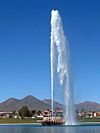 |
Fountain Lake, Fountain Hills, Arizona |
1970 | World's tallest fountain when built (562 feet). Now the fourth-tallest in the world, second-tallest in the U.S. |
||
| Fountain of the Rings | 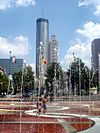 |
Centennial Olympic Park, Atlanta, Georgia |
EDAW, Inc. William Hobbs, Ltd. |
1996 | Made for the 1996 Olympic Games. | |
| Fountain of Time |  |
Chicago, Illinois | Lorado Taft | 1922 | "Father Time" | |
| Fountains of Bellagio |  |
Bellagio Resort, Las Vegas, Nevada |
WET (Water Entertainment Technologies) | 1998 | Water and light show set to music. | |
| Gateway Geyser | 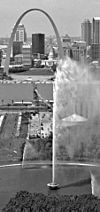 |
Malcolm W. Martin Memorial Park, East St. Louis, Illinois |
1995 |
Tallest fountain in the U.S. (630 ft), second-tallest in the world. Matches the height of the Gateway Arch. |
||
| LaFayette Fountain | 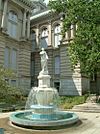 |
Lafayette, Indiana | Lorado Taft | 1882 | This was Taft's first fountain. | |
| Littlefield Fountain |  |
University of Texas at Austin, Austin, Texas |
Morison & Walker Paul Cret |
Pompeo Coppini Waldine Tauch |
1933 | |
| Longwood Gardens |  |
Kennett Square, Pennsylvania | Open Air Theatre, 1914 Italian Water Garden, 1927 Main Fountain Garden, 1931 |
Fountain show in the Open Air Theatre. | ||
| Meeting of the Waters Fountain The Wedding of the Waters |
 |
Aloe Plaza, Saint Louis, Missouri |
Carl Milles | 1940 | Detail. | |
| National World War II Memorial |  |
National Mall, Washington, D.C. |
Friedrich St. Florian | Raymond Kaskey James Peniston |
2004 | From above. |
| Jesse Clyde Nichols Memorial Fountain |  |
Country Club Plaza, Kansas City, Missouri |
McKim, Mead & White | Henri-Léon Gréber | 1910 1960 |
Made for the "Harbor Hill," estate in Roslyn, New York. Four large horse figures represent great rivers: "The Rhine," "The Seine," "The Volga," and "The Mississippi." Moved to Kansas City in 1960. |
| Piazza d'Italia |  |
New Orleans, Louisiana | Charles Williard Moore Perez Architects |
1978 | At night. | |
| Point State Park Fountain |  |
Point State Park, Pittsburgh, Pennsylvania |
1970 | The jet shoots 150 feet. | ||
| Prometheus Fountain |  |
Rockefeller Center, Manhattan, New York City |
Raymond Hood | Paul Manship | 1933 | With ice skaters. |
| Pulitzer Fountain | 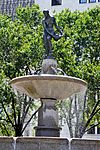 |
Grand Army Plaza, 5th Avenue & Central Park South, Manhattan, New York City |
Thomas Hastings | Karl Bitter Isidore Konti<br>Karl Gruppe |
1916 |
"Pomona" Konti and Gruppe finished the sculpture after Bitter died in 1915. |
| Rackham Memorial Fountain | 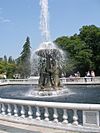 |
Detroit Zoo, Royal Oak, Michigan |
Corrado Parducci | 1939 | ||
| Franklin Delano Roosevelt Memorial |  |
West Potomac Park, Washington, D.C. |
Lawrence Halprin | 1997 | ||
| Russell Ager Memorial Fountain |  |
Detroit, Michigan | Henry Bacon | Daniel Chester French | 1921 | |
| The Sciences and The Arts Fountains | 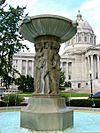 |
Jefferson City, Missouri | Robert Ingersoll Aitken | 1924 | ||
| Scott Memorial Fountain | Belle Isle Park, Detroit, Michigan |
Cass Gilbert | Herbert Adams | 1925 | The lowest part is 510 feet (160 m) wide. | |
| Soldiers' and Sailors' Monument | 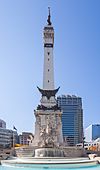 |
Indianapolis, Indiana | Bruno Schmitz | Rudolf Schwarz Frederick MacMonnies George Brewster<br>Nicholas Geiger |
1888 | "War," designed by Frederick William MacMonnies, carved by Rudolf Schwarz. |
| Swann Memorial Fountain Fountain of the Three Rivers |
 |
Logan Circle, Philadelphia, Pennsylvania |
Wilson Eyre | Alexander Stirling Calder | 1924 | "Allegorical Figure of the Schuylkill River" |
| Thatcher Memorial Fountain | 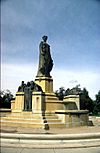 |
City Park, Denver, Colorado |
J.R.M. Morrison | Lorado Taft | 1918 | |
| Tyler Davidson Fountain |  |
Fountain Square, Cincinnati, Ohio |
August von Kreling Ferdinand von Miller Fritz von Miller Ferdinand Freiherr von Miller |
1871 |
"The Genius of Water" Designed in the 1840s for King Ludwig of Bavaria, but not built then. It was made in Germany in 1870 and sent to the U.S. |
|
| Unisphere | 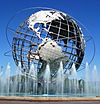 |
Flushing Meadows Park, Queens, New York City |
Gilmore D. Clarke | 1964 | The Unisphere was the main feature of the 1964 New York World's Fair. | |
| Vaillancourt Fountain "Quebec Libre!" |
 |
Justin Herman Plaza, San Francisco, California |
Armand Vaillancourt | 1971 | The plaza from above. |


